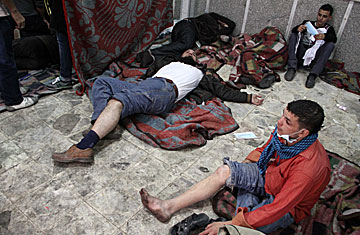
Protesters wounded in clashes with Egyptian riot police in Cairo's Tahrir Square wait in a field hospital on Nov. 20, 2011
The field hospital in the dark and dirty alley behind Hardee's is up and running once again, just as it was during the first two months of the year. Volunteer medics wearing gloves and surgical masks — the masks, a futile attempt to mitigate the sharp sting of tear gas in the air — lean over the wounded activists who have been ferried in on the backs of motorcycles. Just past the field hospital, in Cairo's Tahrir Square and its side streets, is a scene that is still more familiar. There, for nearly 36 hours, Egyptian protesters have clashed with the government's security forces, exchanging rocks and Molotov cocktails for tear gas and rubber bullets, as others lead chants for freedom and the downfall of the regime. It is as if the revolution that began on Jan. 25 and seemed to culminate with the Feb. 11 fall of President Hosni Mubarak had begun all over again.
The Egyptian capital's latest unraveling came as authorities tried to clear the square in downtown Cairo following a mass protest on Friday. Islamists and young liberals had gathered to protest a proposed set of "supraconstitutional" principles that would place the military largely outside the realm of judicial and parliamentary supervision, as well as giving the institution wide veto power over the development of the next government and constitution. By Friday night, most of the day's protesters had packed up and gone home. But hundreds of mostly youth activists remained in the square, and when the police moved in overnight to dismantle the protest camp with tear gas, rubber bullets and shotgun pellets, the demonstration only swelled. By Sunday night, clashes continued in and around the square, even as the military moved in to join the ranks of Egypt's central security. And demonstrations had spread to the coastal cities of Alexandria and Suez. The Egyptian Health Ministry put the death toll at three since Friday, with nearly a thousand injured.
Demonstrators in Tahrir Square now say they are calling for a timetable by which the military will pledge a handover of power to a civilian government. But some say the protest is broader than that — a continuation of the winter revolution, which young activists increasingly say failed to topple little more than Mubarak. "The revolution is not over. The military council is the same as Mubarak," said Abdu Kassem, a 25-year-old protester wearing a tag that read "The Continuous Revolution."
Tahrir Square is rife with comparisons. Indeed, many likened the scene of tear gas and mayhem on Sunday to that of the early days of the uprising, when hundreds of thousands of protesters battled police forces across the country. "We're going back to the days of Jan. 25. There are no differences," said Marina Azmi, a 20-year-old university student, gesturing to the tear-gas-filled streets.
But there are critical differences. Though thousands joined the protests over the weekend, their numbers paled in comparison with those who massed during the uprising, or even several protests since. And in neighborhoods just past Tahrir Square's perimeter, life continued largely as usual; businesses and schools remained open, and pedestrians ran errands. "In Dar el-Salaam neighborhood, where I live, there is nothing happening. There is nothing happening in other places. The people are not seeing what we see," explains Sabrine Mamdouh, who sells tea to protesters from the edge of the square. She says popular ignorance about the events in Tahrir Square may be one reason the protest had failed to garner larger numbers, but it's also because most Egyptians, just like herself, are busy confronting the same daily struggles as before. "From the 25th of January till today, [my family is] still 11,000 LE [Egyptian pounds] in debt. I hope things calm down, because if things stay as they are, it will only get worse."
Egypt is set to hold its first democratic election on Nov. 28. Some predict the vote will attract a record turnout in a country long accustomed to neglecting rigged ballot boxes under Mubarak. But others — particularly the liberal youth who helped lead the January uprising — say the country is far from ready, and some have threatened to boycott the vote. Islamist parties like the one belonging to Mubarak's longtime opposition, the Muslim Brotherhood, have the advantage, they argue, because they've been around the longest. Many others are angry that a recent court ruling failed to bar former ruling-party members from the race.
But the outcome of the latest protests may yet determine whether they'll even have a choice. "I think this event, if it continues, it will delay the elections," says Ahmed Maher, the leader of the April 6 Youth Movement, which played a critical role in mobilizing youth last winter, and who participated in the protests over the weekend. Some, including the country's transitional authorities, have warned that further protests could undermine the transition to democracy. And Maher says that like other political organizations, his is currently weighing what step to take next. "I am getting many calls right now from colleagues asking to start a sit-in in Tahrir. But we must think first," he says. A sit-in would surely escalate the situation — potentially delaying the vote. But backing out now might cede a victory to the military. "We're going to have a meeting to decide on the demands. And after that we will also decide about the elections."
